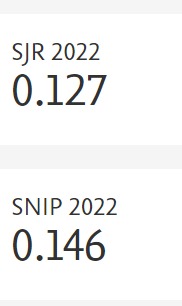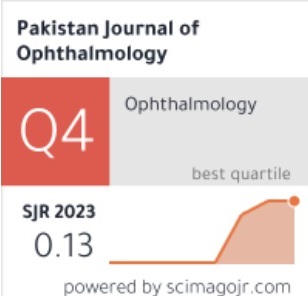The Strabismus Prevalence in a Random Sample of Iran's Northeastern Population
Doi: 10.36351/pjo.v40i1.1688
DOI:
https://doi.org/10.36351/pjo.v40i1.1688Abstract
Purpose: To investigate prevalence of strabismus and related factors in Mashhad, Iran.
Study Design: Cross sectional study.
Place and Duration of Study: Khatam-al-Anbia Hospital, affiliated with Mashhad University of Medical Sciences.
Methods: Using multistage cluster sampling, participants were selected. All participants underwent detailed ocular examinations. A unilateral cover test was performed with the prism bar to achieve binocular alignment. Deviation magnitude was determined by considering the best refractive correction. Fixation targets were chosen as single letters one line above the best-corrected visual acuity on the distance and near chart.
Results: This study included 5054 participants with a mean age of 35.35 ± 19.4 years. Strabismus was detected in 110 participants (2.17%) including 26 (0.51%) with esodeviation, 74 (1.46%) with exodeviation, and 10 (0.19%) with vertical deviation. The prevalence rates for strabismus, exotropia and esotropia were 2.38%, 1.64%, and 0.56% in females and 2.00%, 1.31%, and 0.51% in males respectively. The results did not indicate a significant gender difference in terms of strabismus prevalence (p>0.05). Among the deviated eyes, there were 25.5% with hyperopia, 39.1% with myopia, and 35.5% with emmetropia. Anisometropia and amblyopia rates were 2.79% and 2.55%, respectively. The results did not reveal a significant correlation between strabismus prevalence, exotropia, and esotropia and age (p=0.56). The familial strabismus prevalence was 5.45%.
Conclusion: Exotropia was more prevalent form of strabismus. Myopia was the dominant refractive error associated with deviated eyes. Tropia showed no age-related association.
Downloads
Published
How to Cite
Issue
Section
License
Copyright (c) 2023 Akbar Derakhshan , Aliakbar Sabermoghaddam, Milad Abdolahian , Siamak Zarei Ganavati , Mohammad Taghi Shakeri , Mehran alirezaei , Athar Zareei , Shahram Bamdad

This work is licensed under a Creative Commons Attribution-NonCommercial 4.0 International License.






